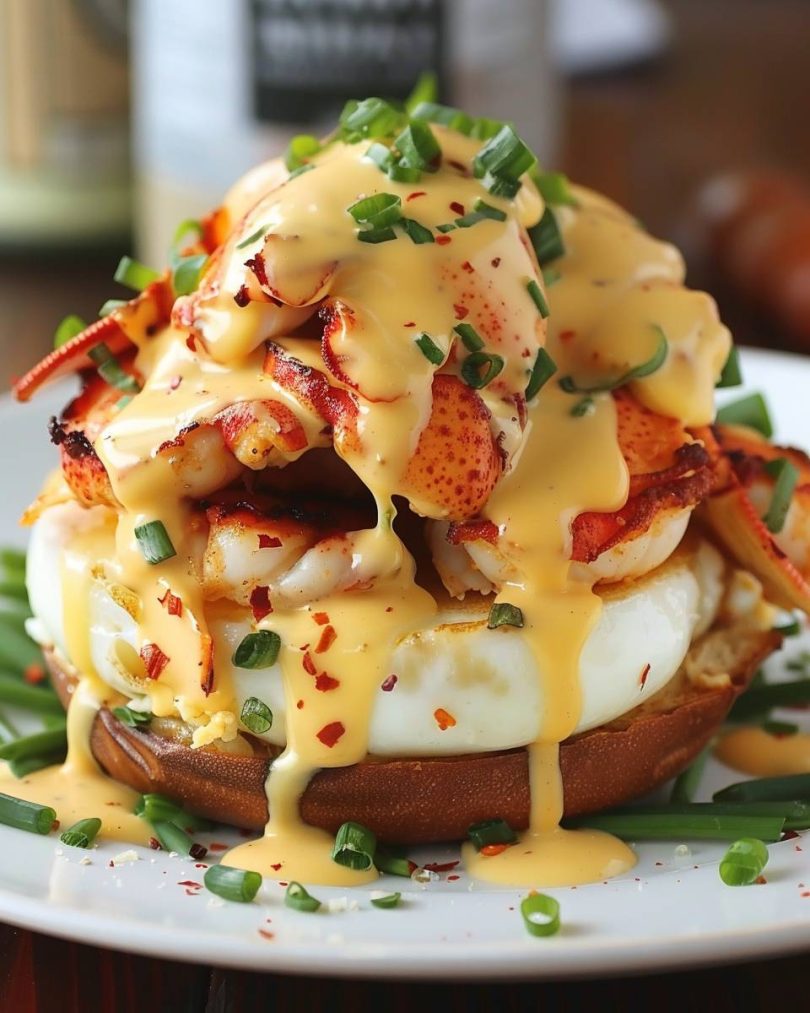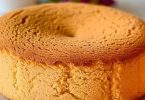Exploring Bay Lobster Eggs Benedict with Cajun Hollandaise: A Brunch Revolution with a Cajun Twist
Embark on a culinary journey with Bay Lobster Eggs Benedict, enriched by vibrant Cajun Hollandaise sauce. This dish celebrates flavors, blending bay lobster’s sweetness with fiery Cajun spices. It is adored by brunch enthusiasts and seafood lovers, adding luxury to traditional Eggs Benedict. Ideal for special mornings, it elevates your brunch to a gourmet experience. Known also as Moreton Bay bug, Bay Lobster’s tender flesh complements the rich, spicy hollandaise.
Creating this dish requires precise timing and technique to perfect every element. Cajun Hollandaise isn’t just a sauce; it’s the heart of the dish, infusing smoky and spicy flavors that enhance the lobster’s sweetness. Suitable for seasoned chefs or weekend cooks, mastering this recipe will boost your cooking skills and impress guests. Explore the steps to make this decadent brunch staple and see why it’s a favorite in culinary circles.
Eggs Benedict: The Brunch Classic’s Surprising Origins
The origins of Eggs Benedict are as rich and layered as the dish itself. A true staple of American brunch menus, this beloved dish has a history shrouded in tantalizing tales and culinary lore. One popular story traces its birth to New York City’s Waldorf Hotel in the late 1800s, where a hungover patron named Lemuel Benedict ordered “buttered toast, poached eggs, crisp bacon, and a hooker of hollandaise.” The maître d’hôtel was so impressed that he adapted the dish to the menu, substituting ham for bacon and an English muffin for toast, thus creating the classic Eggs Benedict that we know today. This anecdote not only highlights the serendipitous nature of the dish’s creation but also underscores the hollandaise sauce as a hallmark of culinary elegance.
Despite its association with high-end dining today, the history of Eggs Benedict suggests a more humble and perhaps, accidental beginning. It’s a dish that has evolved over time, embracing various interpretations and ingredients, from the luxurious lobster and salmon versions to regional twists like the addition of avocado or tomato. The adaptability of Eggs Benedict reflects its universal appeal and the ease with which it melds with diverse cuisines. For more fascinating facts about this dish, visit Smithsonian Magazine’s exploration of its origins. Whether served in a five-star restaurant or whipped up in a home kitchen, Eggs Benedict continues to be a centerpiece of modern brunch culture, making it a perfect example of culinary evolution and creativity.
Spicing Up Brunch: The Cajun Twist on Classic Dishes
Cajun cuisine, a robust cornerstone of American cooking, brings a zest that can transform any dish from ordinary to extraordinary. Known for its vibrant spices and hearty flavors, this culinary style originates from the French-speaking Acadian people who settled in Louisiana. Over the years, Cajun cooking has become synonymous with dishes that are not only filling but also bursting with flavor. Incorporating Cajun spices into traditional recipes like Eggs Benedict adds a delightful kick, turning an already beloved dish into something unexpectedly tantalizing. The key lies in the liberal use of ingredients such as cayenne pepper, paprika, and garlic, which are staples in the Cajun pantry.
When it comes to brunch, the inclusion of Cajun Hollandaise sauce in Bay Lobster Eggs Benedict is a perfect example of this influence at play. Unlike the traditional mild hollandaise, the Cajun version is enlivened with a dash of chili powder and smoked paprika, offering a smoky, spicy layer that complements the sweet flesh of the Bay Lobster beautifully. This culinary fusion not only enhances the flavors but also adds a colorful narrative to the dish, inviting diners to explore a blend of cultures on their plates.
Celebrity Seal of Approval: Chefs and Stars Who Love Eggs Benedict
Eggs Benedict, a dish so versatile and beloved, often finds itself on the social media pages and restaurant menus of celebrity chefs and Hollywood stars. It’s not just the everyday brunch-goer who swoons over this luxurious dish; celebrities have been known to endorse their favorite versions of it, adding a dash of glamour to its creamy, eggy allure. Gordon Ramsay, renowned for his culinary prowess and fiery personality, once featured a lobster version of Eggs Benedict on his TV show, praising its perfect balance of rich flavors. This endorsement not only boosted the dish’s popularity but also highlighted how classic recipes could be elevated to haute cuisine, inspiring food enthusiasts to experiment with their renditions.
Moreover, the endorsement by celebrities extends beyond the kitchen. Stars like Oprah Winfrey and Gwyneth Paltrow have been spotted enjoying their special takes on Eggs Benedict at trendy brunch spots, often sharing their experiences with fans online. These moments, captured on Instagram or discussed in interviews, add a layer of relatability and aspiration to the dish, enticing fans to try these star-favored recipes at home or in restaurants. For a fun look at how celebrities influence dining trends, check out this engaging article from Eater, which discusses the impact of star endorsements on what we eat. Such endorsements not only validate the dish’s status in the culinary world but also showcase the universal appeal of Eggs Benedict, from kitchen novices to Michelin-starred chefs.
Why Bay Lobster Eggs Benedict with Cajun Hollandaise is the Ultimate Brunch Delight
Brunch is more than just a meal; it’s a weekend ritual, and the Bay Lobster Eggs Benedict with Cajun Hollandaise is a star dish that makes any brunch menu shine. This recipe elevates the typical brunch fare with its luxurious twist, combining the sweet, succulent flavors of bay lobster with the bold, spicy kick of Cajun hollandaise. Not only does it offer a symphony of flavors, but it also brings a touch of elegance to the brunch table, making it perfect for special occasions or simply to pamper yourself on a lazy Sunday morning. Its rich ingredients are balanced beautifully with the silky hollandaise, providing a satisfying meal that’s both comforting and sophisticated.
Moreover, this dish scores high on versatility and visual appeal, which are key for that perfect brunch spread. The vibrant color and creamy texture of the Cajun Hollandaise sauce draped over the bright, tender lobster meat and a soft, poached egg, served atop a toasted English muffin, make it a feast for the eyes. It’s not just delicious but also Instagram-worthy, likely to get everyone excited about diving in. Whether you’re hosting a brunch for friends or looking to impress family, Bay Lobster Eggs Benedict with its Cajun twist is a guaranteed showstopper, ensuring your brunch is anything but ordinary.
Crafting the Perfect Bay Lobster Eggs Benedict with Cajun Hollandaise
Transitioning from the rich history and cultural significance of our featured dish, let’s delve into the practical side of creating your own Bay Lobster Eggs Benedict with Cajun Hollandaise. This next section will guide you through the essential ingredients and step-by-step instructions to bring this gourmet brunch to life in your kitchen. With each element carefully chosen to enhance the flavors and textures, this recipe promises a delightful and visually stunning meal that will impress any brunch guest.
The key to a perfect Bay Lobster Eggs Benedict lies in its high-quality ingredients. Freshly toasted English muffins provide the crunchy base for layers of tender lobster, vibrant arugula or spinach, and silky poached eggs, topped with a spicy Cajun hollandaise sauce that ties all the flavors together. Garnishes like chopped chives, paprika, cayenne pepper, and optional microgreens add a final touch of color and flavor that elevate the dish from great to extraordinary.
Ingredients:
4 English muffins, split and toasted
8 eggs (for poaching)
1 tablespoon white vinegar (for poaching water)
8 lobster tail pieces
Arugula or spinach for layering
Chopped chives for garnish
Paprika or cayenne pepper for garnish
Microgreens for garnish (optional)
Cajun Hollandaise
3 egg yolks
1 tablespoon lemon juice
1/2 cup unsalted butter, melted
1/2 teaspoon Cajun seasoning
A pinch of cayenne pepper
Salt to taste
Now that you have your ingredients ready, it’s time to tackle the recipe. This process is simple yet requires precision to ensure each component—from the velvety Cajun hollandaise to the perfectly poached eggs—comes together harmoniously. Follow these steps to craft a dish that’s as beautiful to look at as it is delicious to eat.
Instructions
Prepare the Lobster:
Begin by rinsing the lobster tails under cold water. Using kitchen shears, cut down the center of the shell lengthwise. Carefully pull apart the shell and loosen the meat, lifting it through the cut shell to sit on top, effectively butterflying the tail.
Bring a large pot of salted water to a boil and add the lobster tails. Cook for about 1 minute per ounce of lobster, or until the shells are bright red and the meat is opaque. Remove from water and let cool slightly before slicing each tail into medallions. Set aside.
Make the Hollandaise Sauce:
In a blender, combine the egg yolks and lemon juice. Blend until light in color. Slowly drizzle in the melted butter while blending, until the mixture is thick and creamy. Add the Cajun seasoning, cayenne pepper, and salt. Blend until mixed. Set aside and keep warm.
Poach the Eggs:
Bring a pot of water to a gentle simmer and add the white vinegar. Crack eggs one at a time into a small bowl and gently slide them into the simmering water. Cook for 3 to 4 minutes until the whites are set but yolks remain runny. Remove with a slotted spoon and drain on a paper towel.
Assemble the Dish:
Place a layer of arugula or spinach on each muffin half. Top with lobster slices, followed by a poached egg.
Pour the warm Cajun hollandaise sauce over each egg. Sprinkle with chopped chives, paprika or cayenne pepper, and microgreens if using.
Mastering Bay Lobster Eggs Benedict: Variations, Nutritional Insights, and Expert Tips
Variations and Serving Suggestions
Exploring variations of Bay Lobster Eggs Benedict can cater to diverse palates and dietary preferences. One popular variation is using smoked salmon instead of lobster, which offers a different texture and flavor profile while still complementing the rich, spicy Cajun hollandaise. For a vegetarian twist, thick slices of portobello mushrooms can be an excellent substitute for lobster. They provide a meaty texture that absorbs flavors beautifully.
When serving, consider different types of bread such as ciabatta or sourdough to add a rustic touch to the dish. For low-carb options, cloud bread or a thick, grilled vegetable slice like eggplant can serve as a creative base. Pairing the dish with a light, citrusy salad or a side of fruit can balance the richness of the hollandaise and lobster. Drinks like a crisp white wine or a Bloody Mary can elevate the brunch experience, making it feel like a special occasion.
Nutritional Information
Bay Lobster Eggs Benedict, while indulgent, also packs a nutritional punch. Lobster is an excellent source of high-quality protein and is low in fat, providing about 28 grams of protein per cup with only 1.2 grams of fat. It’s also rich in minerals like phosphorus, which aids in kidney function and bone health, and zinc, crucial for immune health. The Cajun hollandaise, though high in calories due to butter, can be modified with low-fat alternatives or made in smaller quantities to drizzle lightly.
The eggs in the dish are a good source of protein and vitamins D, B12, and selenium, essential for various bodily functions from bone health to immune response. Considering the whole dish, one serving can contain approximately 400-500 calories, making it a substantial meal option. Balance this by serving with a side of vegetables or opting for lighter ingredients in other meals throughout the day.
FAQs About Bay Lobster Eggs Benedict
- What are the best lobsters to use for this recipe?
Opt for fresh, high-quality bay lobster tails for the best flavor. Frozen tails can also work but ensure they are thoroughly thawed and properly prepared.
- How can I ensure my hollandaise sauce doesn’t curdle?
Keep the heat low and add the butter slowly while continuously whisking. If it starts to split, a tablespoon of cold water whisked in can help salvage it.
- Can I prepare any components in advance?
The lobster can be cooked and sliced a day ahead. The hollandaise sauce can be made a few hours in advance, kept warm on very low heat or in a thermos.
- Are there any quick fixes if my poached eggs don’t come out right?
Practice makes perfect with poached eggs. Use fresh eggs, add a bit of vinegar to the water, and ensure the water is just simmering, not boiling.
Tips on Buying and Preparing Bay Lobster
When purchasing bay lobster, freshness is key. Look for lobsters that are lively if buying live, or tails that are firm and not slimy if pre-cooked. The smell should be fresh and briny, not fishy. Storing lobster correctly is also crucial. Keep it in the coldest part of your refrigerator and cook within a day or two of purchase.
For preparation, be sure to handle the lobster gently. Cook it just until the meat is opaque to avoid toughness. Poaching in lightly salted water can enhance its natural flavors without overwhelming its delicate texture. Always cool cooked lobster quickly in ice water to stop the cooking process and preserve its tenderness.
Bay Lobster Eggs Benedict with Cajun Hollandaise is more than just a meal. It’s a culinary adventure that offers a twist on a classic favorite. Whether you stick to the traditional recipe or experiment with variations, this dish is sure to impress. With its rich flavors, nutritional benefits, and adaptability, it’s the perfect centerpiece for any brunch gathering. So, gather your ingredients, and get ready to enjoy a brunch worth remembering!






